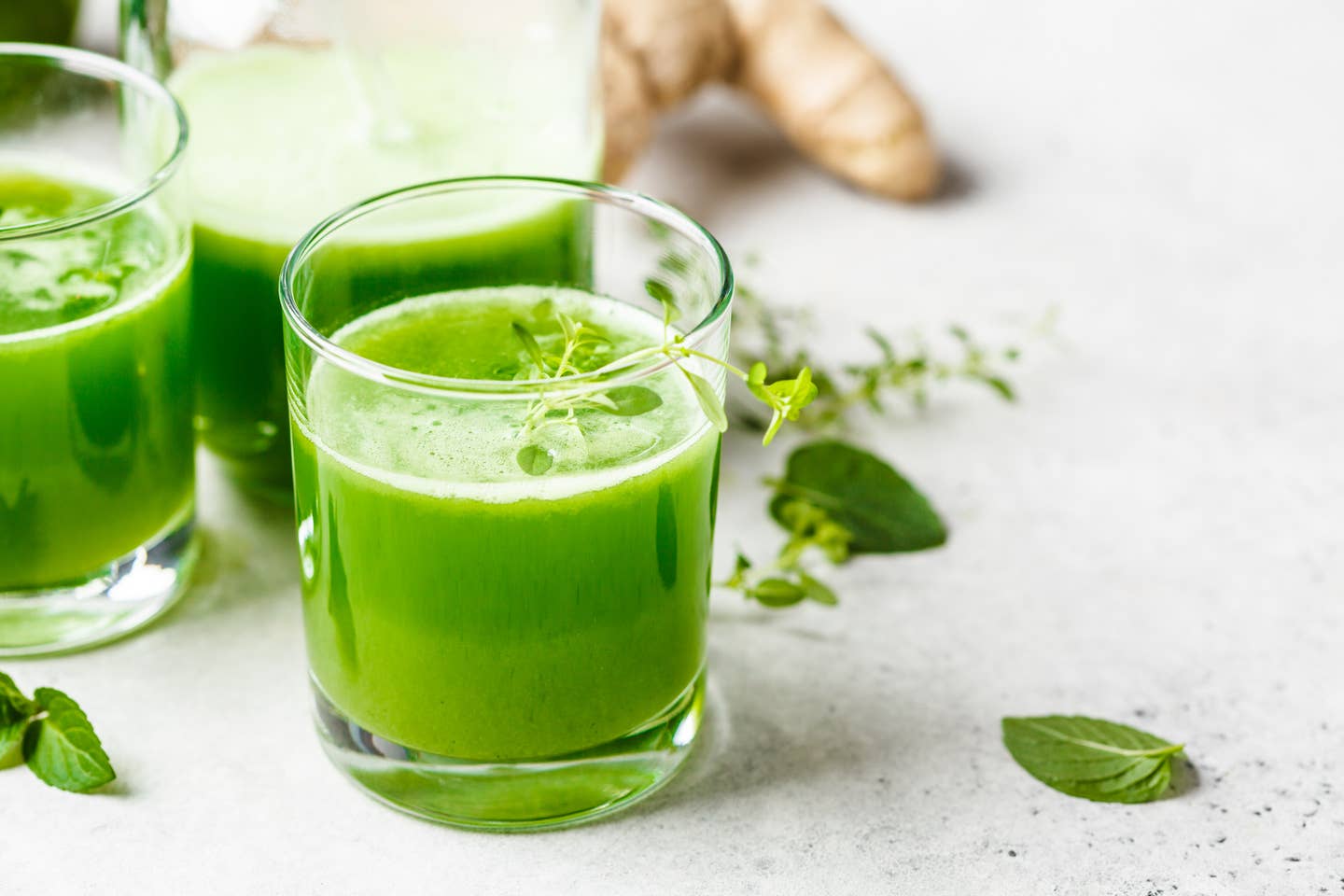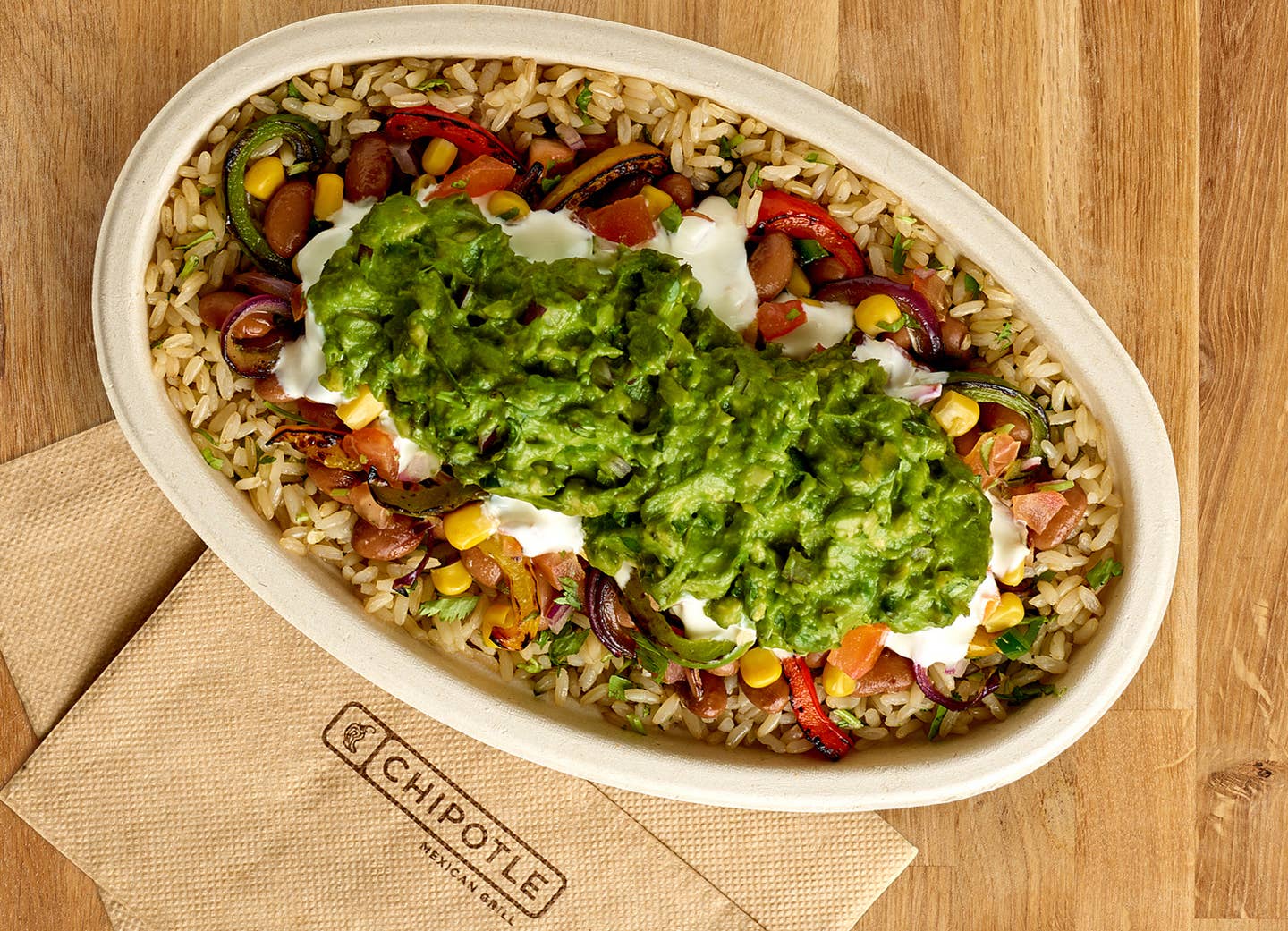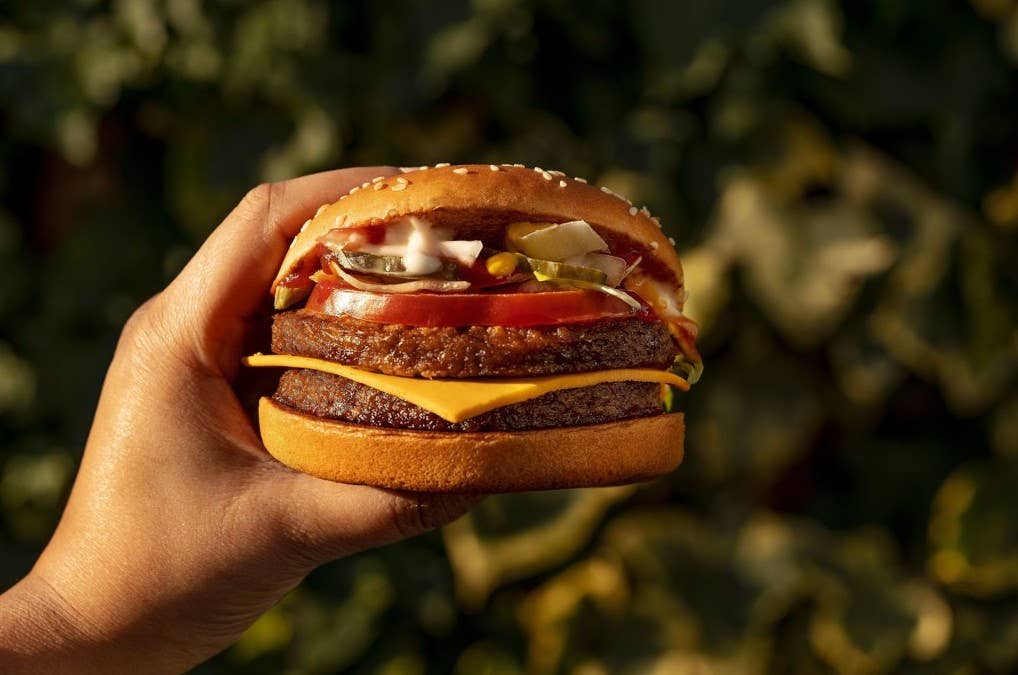
To Lose Weight Fast and Keep It Off, Just Start Juicing, Studies Find
As New Year's resolutions loom on the horizon, many are asking themselves what the best way to get healthier and lose weight naturally is. One often-cited study shows that the best way to jumpstart weight loss and improve gut health (to lower inflammation) quickly is a short but deliberate juice fast, even if you only swap out some of your meals for juicing.
By increasing the number of fruits and vegetables you intake, by juicing, you can positively impact your gut's balance of micro-organisms, which make up your microbiome, to switch it over toward healthy bacteria–which feed on vegetables, fruit, and the fiber they contain–from those that feed on saturated fat, meat, dairy, and toxins. That means you will not only lose weight but create a cascade of health benefits throughout the body that include opening up your blood vessels, delivering more oxygen to the muscles (with nitric oxide from the fruit and vegetable juice), and allowing yourself to feel more energetic, recover from workouts faster and feel all-around more like Superman or Superwoman, all from just adding plant-based foods to your diet, the more the better.
According to the study, just three days of juicing is enough to switch over the gut microbiome from inflammatory bacteria to good bacteria, meaning you train your body to shed pounds and hit reset, fast.
There's no better way to lose weight and do a healthy cleanse, the study tells us than to start juicing, at least one meal a day. Juicing, especially with a variety of vegetable juices from beets, dark leafy greens, and other intensely colored vegetables, adds important plant antioxidants, present in the pigments of the juice, called polyphenols that not only help us shed fat faster but detox all those extra empty calories and unhealthy gut bacteria from a long weekend of over-indulging (with booze, meat, sweets, and whatever else we allowed ourselves in the name of enjoying the long-awaited chance to socialize with friends). Juicing works by adding fiber and nutrients to your body and allowing your gut to empty itself of bad bacteria that metabolize meat and dairy to the so-called healthy gut bacteria that fights inflammation, and literally start fresh.
"Vegetable and fruit juices provide polyphenols... fiber, and nitrates (especially in beet juice), which may induce a prebiotic-like effect," the study authors state. They set out to find out if three days of juicing would have significant health benefits and found that on day four, all serious health markers were improved, including weight loss.
The study put 20 healthy adults on a juice diet for three days and then had them eat normally afterward for 14 days, and the weight loss from the juicing lasted until the end of the experiment, so even after the subjects went back to their customary diet, the juice fasting weight stayed off, indicating that this type of new healthy gut microbiome was doing its job.
"On day 4 we observed a significant decrease in weight and body mass index," the authors reported, "which was maintained until day 17. On day 4 the proportion of the phylum Firmicutes and Proteobacteria [bad bacteria] in stool was significantly decreased and Bacteroidetes and Cyanobacteria [good bacteria] was increased compared to baseline and was partially reversed on day 17."
Also on day four, they reported that "plasma and urine nitric oxide was increased by 89 percent and 360 percent, respectively," while the number of unhealthy lipids in the body had fallen by more than 20 percent, which meant that heart health was also improved. "General well-being score was increased at the end of the study," the authors concluded. "In summary, a 3-day juice-based diet altered the intestinal microbiota associated with weight loss," which stayed off for 17 days of the study, and an increase in Nitric Oxide, plus a decrease in lipid oxidation.
This was so significant that even a partial juice fast is likely to benefit you. Here is how to make a healthy green juice based on this study, with green vegetables, and a small amount of mint, cucumber, and lemon juice to sweeten the drink enough to make it palatable.
For five detox juice recipes to cleanse your body and lose weight, click here.
Green Juice
Serves 1
Ingredients
- 1 head of celery, stalks removed
- 1 bunch of mint
- 1/2 bunch of parsley
- 1 cucumber
- 1 lemon
Instructions
- Put it all through a juicer and drink immediately.
Beet juice, specifically, carries more health benefits than other vegetables or plants, because of the fact that it contains a plant pigment that makes it an intense color or red called betalains. These phytochemicals are believed to give beets the ability to keep blood pressure low by helping blood vessels stay supple, open, and allow blood to freely flow through them. But they are also indicated in studies as helping the body in fighting cancer, a fact that experts agree makes beet juice a uniquely powerful ingredient to add to your daily routine.
“Beets get their rich color from betalains, which are water-soluble antioxidants, according to a study published in 2016. "Betalains have chemo-preventive capabilities against some cancer cell lines in the body,” explains Shannon Henry, RD, a registered dietitian with EZCare Clinic, an online healthcare service. Betalains are thought to help your immune system search for free radicals and neutralize unstable cells in the body.
In yet another recent study, researchers gave obese female patients a mix of dried fruit and a high-fiber drink of vegetable concentrate and found that the effect of the phytochemicals, or plant-based nutrients, from the fruits and vegetables helped to reduce blood sugar and lower insulin resistance, so fiber from dried fruit can be beneficial as a snack while you are juicing since the fiber can also act as a prebiotic to improve gut health.
Beet Juice
Serves 1
Ingredients
- 2 beets, trimmed, scrubbed, and rinsed
- 1 green apple, rinsed
- 3 carrots, peeled and rinsed
- 1/2 lemon, rinsed
Instructions
- Juice ingredients or add them to a high-speed blender filled with water.
The Top 20 Veggies with the Most Protein
1. Soy Beans
Soybeans are a legume but they are such a great source of protein that we had to lead the veggie list with it. There is more protein in just one ounce of soybeans than a cup of sliced avocado! 1 cup equals Protein - 28.6g Calories - 298 Carbs - 17.1g Fiber - 10.3g Calcium - 175mg
2. Peas
If the pod, that peas are grown in, is split down the middle, that is an indicator they are ripe. Seeds inside the pod vary and can be green, white or yellow. 1 cup equals Protein - 8.6g Calories - 134 Carbs - 25g Fiber - 8.8g Calcium - 43.2 mg
3. Corn
Fresh corn is a great source of energy for those who like to stay active. Protein isn't all that corn has to offer. Corn provides the body with potassium and B vitamins. 1 cup equals Protein - 5.4g Calories - 177 Carbs - 123g Fiber - 4.6g Calcium - 4.9mg
4. Artichoke Hearts
Artichokes are part of the sunflower family. The fiber in artichoke hearts is great for supporting digestion. 1 cup equals Protein - 4.8g Calories - 89 Carbs - 20g Fiber - 14.4g Calcium - 35.2mg
5. Asparagus
If not properly stored, Asparagus tends to go bad quickly, To elongate freshness, put damp paper towels around the stems, or place the entire asparagus bunch in a cup of water (like flowers) to maintain freshness longer. 1 cup equals Protein - 4.4g Calories - 39.6 Carbs - 7.4g Fiber - 3.6g Calcium - 41.4mg
6. Brussel Sprouts
Brussel sprouts have more Vitamin C than an orange. If your Brussel sprouts have a rancid odor that is an indicator you overcooked them. The smell occurs because the sprouts are composed of a great amount of sulforaphane. 1 cup equals Protein - 4g Calories - 56.2 Carbs - 40g Fiber - 4g Calcium - 56.2mg
7. Broccoli
If you are trying to lose weight broccoli is a great addition to your diet because it consists of 90 water and is also high in fiber. 1 cup (chopped) equals Protein - 3.8g Calories - 54.6Carbs - 11.2g Fiber - 5.2g Calcium - 62.4mg
8. Mustard Greens
Mustard greens provide the body with tons of Vitamin A, Vitamin C, Vitamin K and fiber. Adding steamed mustard greens into your diet has been known to lower cholesterol and reduce inflammation. 1 cup equals Protein - 3.2 g Calories - 21 Carbs - 2.9g Fiber - 2.8g Calcium - 104mg
9. Avocado
Avocado is commonly mistaken as a vegetable but it is technically a fruit. This fruit had to be included in our veggie list because it isn't just tasty but super nutritious. Avocados are packed with protein but they are a great source of potassium and fiber. Avocados are a great addition to any salad, sandwich and even smoothie!
10. Onions
Onions are an unappreciated food hero since they provide 20 percent of your daily Vitamin C and deliver an abundance of antioxidants that can reduce inflammation. 1 cup (chopped) equals Protein - 2.9g Calories - 92.4 Carbs - 21.3g Fiber - 2.9g Calcium - 46.2mg
11. Beets
The entire beetroot is edible including the leaves which contain loads of vitamin A, calcium, iron and potassium. Beetroot is high in sugar but is considered one of the most nutritious veggies used in salads and soups. 1 cup equals Protein - 2.8 g Calories - 74.8 Carbs - 17g Fiber - 3.4g Calcium - 27.2mg
12. Oyster Mushrooms
Oyster mushrooms are commonly seen in Chinese dishes. They grow best in a controlled environment indoors. Oyster mushrooms have so many nutrients to offer besides protein such as iron, calcium, zinc and folic acid. 1 cup (raw and sliced) equals Protein - 2.8g Calories - 37 Carbs - 5.6g Fiber - 2.0g Calcium - 2.6mg
13. Bok Choy
Bok Choy is a member of the mustard family. One of the oldest cultivated vegetables in the world, Bok Choy means "white vegetable” and is a great source of vitamins A, C, B6, K, and E, magnesium, potassium, iron, manganese, and calcium. 1 cup equals Protein - 2.7 g Calories - 20.4 Carbs - 3.1g Fiber - 1.7g Calcium - 158mg
14. Green Beans
Green beans are a great source of vitamins B, C and K, and minerals such as magnesium, iron and manganese. Green beans should be cooked before eating, to destroy lectins. China is the biggest grower of green beans in the world, exporting over 15 million tons a year. 1 cup equals Protein - 1.8 g Calories - 31 Carbs - 7 g Fiber - 2.7 g Calcium - 37 mg
15. Cauliflower
The most nutritious way to consume cauliflower is steamed. Don't get intimidated by orange, purple or green cauliflower. All three types have the same benefits as white cauliflower. 1 cup equals Protein - 2.2g Calories - 28.6 Carbs - 5.4g Fiber - 2.8g Calcium - 19.8mg
16. Turnip
You can eat the entire plant, root and leaves. The turnip root is high in vitamin C and the greens are high in vitamins A, C, E, B6 and K, believed to counter inflammation. Add turnip roots to soup, or mash them. Add them to salads. 1 cup equals Protein - 1.6g Calories - 28.8 Carbs - 6.3g Fiber - 5.0g Calcium - 197mg
17. Alfalfa Sprouts
Alfalfa sprouts might be little but they sure are powerful. Plus they're quick and easy to grow. They are loaded with Vitamin C, Vitamin K, Iron and more. But because they have been known to carry bacteria, make sure to fully cook alfalfa sprouts if you have a fragile immune system or are pregnant. 1 cup equals Protein - 1.3 g Calories - 8 Carbs - 0.7 g Fiber - 0.6 g Calcium - 10.6 mg
18. Tomatoes
Keep your tomatoes fresher for longer by storing them stem down. When exposed to sunlight the Vitamin C in a tomato will diminish. 1 cup equals Protein - 1.3g Calories - 26.8 Carbs - 5.8g Fiber - 1.8g Calcium - 14.9mg
19. Zucchini
Zucchini has an abundance of potassium, even more than a banana! The reason zucchini isn't high in calories is that it is made up of 95% water. 1 cup equals Protein - 1.2g Calories - 28.8 Carbs - 7.1g Fiber - 2.5g Calcium - 23.4 mg
20. Spinach
Spinach is filled with Vitamin A, Vitamin E, Vitamin K, fiber and protein. The best part about spinach is you can sauté it, blend it or eat it raw! Spinach is best grown in rainy and cool weather. 1 cup equals Protein - 0.9g Calories - 6.4 Carbs - 1.0 g Fiber - 0.6g Calcium - 27.7 mg
More From The Beet






